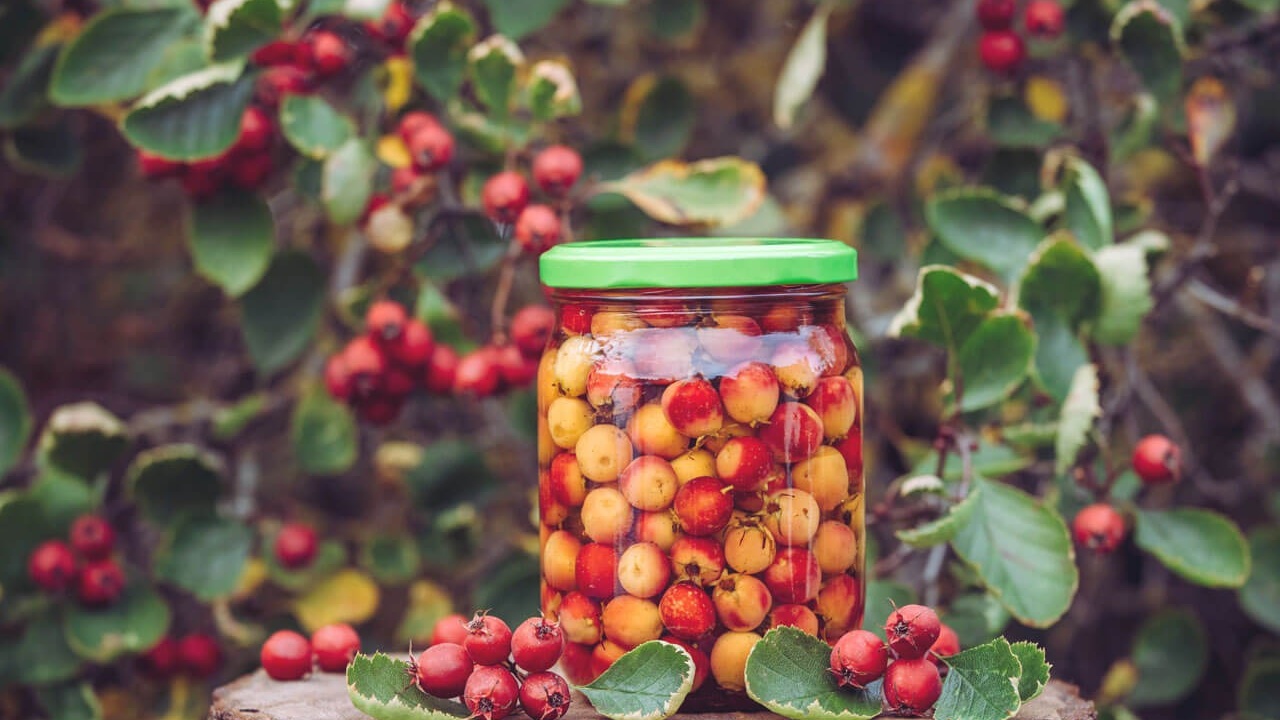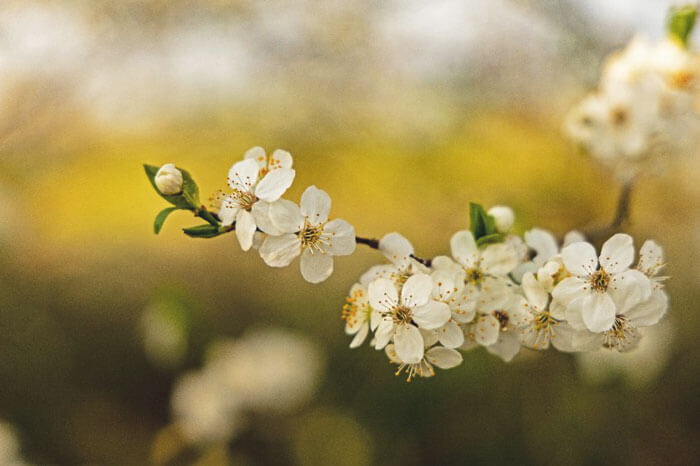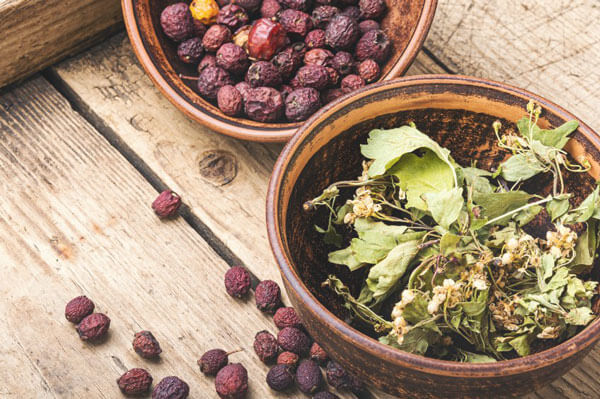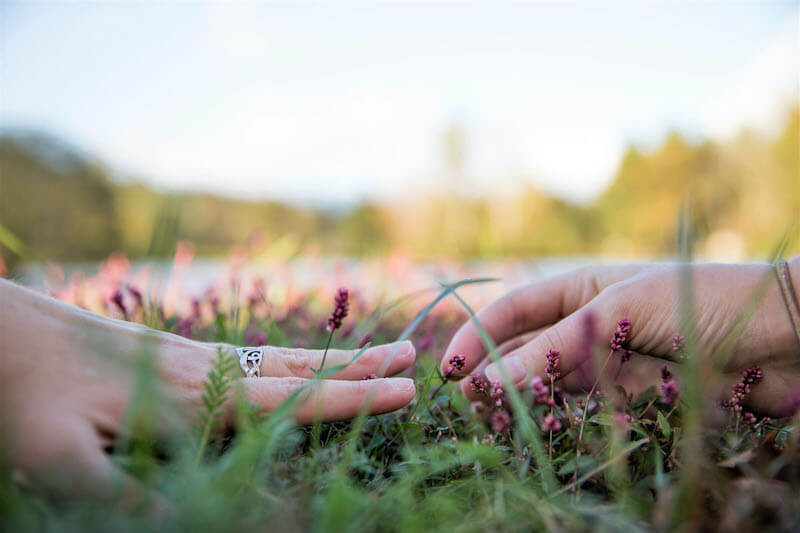Hawthorne Berry as Herbal Medicine for Healing Your Heart

by Corinna Wood
Many years ago I planted a hawthorn tree in my garden. I'm glad I got started way back then!
It took a decade for this little tree to mature to produce the beloved berries—just in time to support my heart through my menopausal transition.
Hawthorn berry is a prime ally in the wise woman medicine chest for tonifying your heart through all ages and stages.
And couldn’t we all use some healing for our hearts—physically and emotionally?
Hawthorn herb is your gal!
In the article, you’ll learn several easy and fun methods to extract the medicinal hawthorn berry benefits to support your heart through the seasons of your life.
Table of Contents
- Hawthorn herb
- EagleSong’s Hawthorn Herbal Botanica
- Healing for a broken heart
Hawthorn herb — hawthorn flower, hawthorn leaf & hawthorn berry
Botanically, hawthorn is a bush or tree in the Rose family—along with many fruit trees, including apple, pear, cherry, peach, raspberries, blackberries, and mulberry.
 When you look closely at the hawthorn flowers, you’ll see their resemblance to the pattern of petals that characterizes the Rose plant family—radially symmetric, generally with 5 petals.
When you look closely at the hawthorn flowers, you’ll see their resemblance to the pattern of petals that characterizes the Rose plant family—radially symmetric, generally with 5 petals.
All parts of the hawthorn are beneficial—hawthorn flower, hawthorn leaf, and hawthorn berry.
However, it’s the berry that’s considered the most potent and is most commonly used medicinally.
Hawthorn berries reach peak potency as they ripen to deep red in the fall.
That’s when you know it’s prime time to harvest the berries for your hawthorn herbal medicine concoctions.
Hawthorn trees—known by the Latin genus name, Crataegus—have a long history of medicinal use around the world.
In old Europe, they were often grown in hedges!
In fact, the Hawthorne surname in olden times denoted someone who lived by a bush or hedge of hawthorn.
Traditionally, both “hawthorne” and “hawthorn” have been used to refer to this medicinal bush prized for its berries—the haw—surrounded by thorns.
A beloved healing herb in the wise woman herbal medicine chest, hawthorn shows you how the lines between food and medicine blur.
When you engage the hawthorn berry benefits, your food becomes your medicine, and your medicine becomes your food.
There are many forms to play with—from water-based tea and decoction, to alcohol-based tincture and vinegar-based oxymel. From not only the berries—but also the hawthorn flowers and leaves.
Curious to hear more? Come, let’s explore these lovely hawthorn trees along the wise woman path . . .
As you know, it's essential to positively identify any plants you're harvesting for food or medicine. First things first: Grab my free guide on 3 Poisonous Plants to Watch Out For (pdf) so you can stay safe on your herbal adventures.
EagleSong’s Hawthorn Herbal Botanica
 To give you the scoop on this powerful herb, I reached out to a beloved wise woman herbalist sister who specializes in hawthorn.
To give you the scoop on this powerful herb, I reached out to a beloved wise woman herbalist sister who specializes in hawthorn.
EagleSong Gardener was my first herb teacher, over 30 years ago. I was a college student hungry for more than I could find in the halls of the academy.
I’d been doing independent study in botany and wild plants. To have EagleSong take me by the hand and share the herbs she knows and loves, was a revelation . . .
You actually eat dandelion in your salads? You pick the hawthorn berries to make your own herbal medicine?
EagleSong’s passion for hawthorn is unparalleled— traveling around the world to explore the botany and folklore of traditional uses of hawthorn, and brewing up an amazing variety of hawthorn concoctions in her kitchen apothecary.
My personal favorite? Her luscious hawthorn oxymel.
But I get ahead of myself.
I invite you to dive into botanical and culinary highlights of hawthorn with EagleSong, the “Hawthorn Whisperer” herself. In EagleSong's words . . .
Where do you find hawthorn (aka hawthorne)?
Hawthorn, Crataegus spp., is the epitome of a common plant, proliferating around planet Earth in the temperate northern latitudes.
A member of the congenial Rosaceae family, this small to medium tree takes her place in rough environments with grace and even charm.
There are thousands of species of Crataegus found around the world!
Growing 10’-50’ with small pome fruits, haws, and often sharp, thorny branches, Crataegus are used as specimen trees in gardens, as a foundation tree in countryside hedges, in orchards in China and Mexico—and as a gnarly free agent in neglected landscapes providing shelter and food for innumerable insects, birds, amphibians, small mammals and, occasionally, humans!
The name hawthorn is an old English word for hedgethorn. Before that the term “hag”meant hedge. Hence, the gnarly old hag of the hedge!
Whitethorn, Crataegus oxycantha and C. monogyna, predominate as shrubby trees used in European hedges—along with its thorny counterpart the blackthorn, sloe plum, Prunus spinosa!
An exceptionally vigorous and adaptive tree, Crataegus occasionally resort to apomixis—a form of asexual reproduction not requiring cross fertilization to create entirely new species.
Two other commonly used herbs with this capacity are Taraxacum and Alchemilla, our friends and allies, dandelion and Lady's mantle.
Somehow, this just tickles my fancy!
Getting to know hawthorn as a medicinal food
Generally recognized as a food with special properties wherever it grows, hawthorn preparations include haw candies, juice, wine, herbal medicines—and is used fresh and dried in soups, teas, punches, jams, butters, chutneys and relishes.
Like many herbal allies, hawthorn is not universally accepted as beneficial. At least one county in Washington state has listed the hawthorn as an invasive species. Ironically, this is the county where I harvest most of the haw used in my practice.
Heart health is a major concern in our communities and the world. By misunderstanding the medicine of herbal allies from the ground up, an opportunity for healing and connection may be missed.
Considered a “heart food” and heart remedy of excellent proportion by many herbalists in several traditions, hawthorn is one of the herbs which, personally, brings me great joy in tending.
Wanting to have this tree more deeply entwined in my life, I set myself the task of finding as many ways as possible to bring hawthorn into our daily diet. I invite you to do the same.
As you get to know each other, remember to wrap your senses around this gnarly little tree, her leaves and flowers, her fruits and if you have the good fortune to be physically close to a hawthorn tree, her nature through the seasons.
- Can you taste the sweet and sour in the haws? The hint of bitter?
- What do the leaves and flowers taste like? How do they make your mouth feel?
- How does the tree smell in full bloom?
- Who visits those blossoms along with you?
- How do you feel when you lay down on the earth under her spreading branches and watch the clouds float by?
Please use these recipes and remedies as a jumping off point for nourishing health and wholeness in your life with hawthorn.
When we savor hawthorn’s medicine in her many expressions, perhaps, a deeper understanding of the complexity in one plant may be found...
Over the last few decades, the expansive proliferation of wonderful, delicious herbal preparations flooding into the folk tradition of people’s medicine is mindblowing! Bravo!
Hawthorn Flower & Leaf + English Tea
While visiting England last May, I stayed with Heather, a sister laissez faire gardener whose garden nurtured and nourished me for 3 weeks. Upon arrival the hawthorn in the front garden was in bloom.
I asked if I could cut a few limbs to dry for tea. Heather was most obliging and Hawthorn Flower & Leaf Tea in the common English tradition was born…
Ingredients
1 English tea bag (Any black tea bag will work)
A small handful dried or fresh hawthorn flowers & leaves
Place tea and hawthorn in a 4-6 cup teapot. Add boiling water. Steep covered 5-10 minutes. Enjoy hot or cold with or without milk and/or honey as you like. The English love their tea at least 3-4 times per day.
Hawthorn Fruit (Berry) Decoction 2 Ways
Choose either preparation method 1 or 2.
Ingredients
4 ounces dried hawthorn fruit (berry)
1- 1.5 quarts waterMethod 1: Place hawthorn in water, bring to a slow boil, reduce heat and simmer for 3-4 hours adding water as necessary to maintain at least 1 quart.
Taste the decoction at 1 hour, 2 hours, three hours; how does it change?
Method 2: You can prepare hawthorn fruits as a long-steeped infusion using a 1 quart thermos. The long slow heat of thermos steeping results in a tasty, nourishing long infusion without having to watch the pot!Hawthorn Oxymel Recipe
A delicious vinegar honey combo with hawthorn fruits (berries). This is a classic 1-1-1 oxymel recipe, parts by weight, with the added flower & leaf infusion to prevent the pectin from setting up.
Ingredients
1 pound fresh or frozen hawthorn fruit (berry)
½ pound hawthorn flower/leaf herbal infusion
1 pound apple cider vinegar
1 pound honey (adjust sweetness to taste)
Simmer hawthorn with infusion and vinegar until berries pop, crush with potato masher, let sit until cool.Reheat to just below boil. Cool.
Mash with potato masher, then allow mixture to strain through a mesh sack or jelly bag. Do not squeeze! Return juice to the pan, add honey and heat just enough to dissolve honey.
Bottle while hot. Store in a cool place. Refrigerate after opening.
***The resulting marc can be sieved and used for making chutney, haw butter, BBQ sauce or anything you like. Have fun!
Tangy oxymels preserve the harvest and can be used in many ways.
Enjoy iced with sparkling water for a thirst quenching beverage, add to fruit salad to brighten flavor or to a vinaigrette for a green salad dressing, enjoy off a spoon, or drizzle on pancakes!
Have fun imagining more ways to include this nutrient dense food in your daily diet.
Enjoying hawthorn herb the wise woman way
Could nourishing health really be this much fun?
I think you’ll find making nourishing and tonifying herbal preparations at once satisfying and fulfilling. Engage hawthorn!
This small, ordinary tree holds a foundational place in herbal practice for strengthening the heart muscle; improving digestion and circulation; resolving arterial congestion and lowering blood pressure; and supporting the immune system and increasing longevity.
Hawthorn is filled with anti-inflammatory flavonoids, minerals and nutrients—including magnesium and calcium to nourish and strengthen the whole person.
Although no single constituent can be singled out as the active ingredient, the sum of all her parts brings the magic and medicine of hawthorn to life.
If you want to strengthen a weak heart or carry an old heart into a healthy future consider hawthorn as an ally.
Enjoy! Have fun! Remember...celebrate hawthorn often.
In the field, in the kitchen and in communion as she is embodied within…
Beware…be aware...she is a gnarly old hag!
~EagleSong Gardener, Wise Woman Herbalist
Herbal and emotional healing for a broken heart
 Herbally, hawthorn and motherwort are the two plants at the top of my list for supporting and tonifying the heart and circulatory system.
Herbally, hawthorn and motherwort are the two plants at the top of my list for supporting and tonifying the heart and circulatory system.
When you incorporate hawthorn berry benefits into your life, be patient. Know that it takes time — I suggest taking hawthorn herbal tincture at least 2-6 months before expecting to see results.
It’s also important to remember that healing the heart is most effective when your herbal support is paired with deep and authentic emotional work.
Healing the heart is a process—whether you seek healing of a physical nature or emotional nature, or both.
The journey of healing heartache can be much like the practice of harvesting hawthorn berry—getting to the sweet tender treat requires care and diligence.
Just as time is required for hawthorn berry tincture to address the physical heart, patience and consistency are needed when tending to heartbreak.
Speaking for myself . . . I must say, after getting tangled up in some thorny relationships in my early years, the sweetness of secure bond with my beloved is that much more to savor.
Like growing that thorny tree—which over time offered juicy, sweet berries—the journey towards healing took time.
Sometimes I wondered if I would ever move beyond the heartache. With patience and persistence, that deep and hard work has provided manyfold harvests.
For deep heart healing, the combination of hawthorn’s physical support along with self-reflective emotional work for healing heartache and heartbreak is a powerful holistic prescription.
I love the ritual of making hawthorn berry herbal tincture each fall—it always opens my heart just to connect with this tree out in the field!
Do It Yourself ~ Making Hawthorne Berry Tincture
 Once you locate your source of fresh hawthorn berry (aka hawthorne berry), making your own hawthorn herbal medicine tincture is easy!
Once you locate your source of fresh hawthorn berry (aka hawthorne berry), making your own hawthorn herbal medicine tincture is easy!
The constituents of hawthorn berry extract readily into 100 proof alcohol, which is 50% alcohol and 50% water.
In making tinctures the wise woman way, I always prefer to work with fresh herbs when available, and hawthorn is no exception.
So bring on those berries this fall!
Supplies:
- Fresh hawthorn berries
- A jar with lid, sized to be filled by your hawthorn berries
- 100 proof alcohol, at least as much as the volume of your jar
To make your own hawthorn berry tincture, follow these easy steps:
- Fill a jar to the top with the hawthorn berries, packed tight
- Fill the jar to the top again, with 100-proof vodka, and cap it
- Label the jar — Hawthorn berry, 100 pf vodka, 10/20/2020
- Top off the liquid level the next day
- Leave your tincture brewing on your counter for six weeks
- Strain out the plant material
Voila, now you have your own potent homemade hawthorn herbal medicine tincture!
Store the tincture in a cabinet out of direct sunlight (or an amber bottle); potency will be retained for at least 3-5 years.
Take 1-3 droppersful (30 drops each) once or twice a day.
Bring hawthorn berry benefits into your life
 As you can see, there are a myriad of ways to bring hawthorn herb into your kitchen and your medicine chest—from teas and decoctions to oxymels and tinctures.
As you can see, there are a myriad of ways to bring hawthorn herb into your kitchen and your medicine chest—from teas and decoctions to oxymels and tinctures.
Think of hawthorn as a nourishing, medicinal food.
The more ways you can bring her into your life, the more she can support your heart and your health.
While the flowers can be used when they bloom in springtime—and the leaves year round—it’s hawthorn berry that is generally considered the most potent part of the plant medicinally.
Hawthorn berry benefits have a long history of medicinal use as a restorative tonic for the heart and cardiovascular system as well as increasing immunity. Hawthorn berry regulates the circulatory system for people with arrhythmia and tachycardia.
Hawthorn berries ripen to peak potency in the fall, so keep an eye out throughout the year for hawthorn bushes or trees along your stomping grounds. And then remember to return in the fall to check for the deepening red ripening hawthorn berries.
I always find that making your own herbal medicines gives you double the benefit—the healing starts right outside, picking those beautiful berries!
I find the last harvests of the season during the waning days of autumn to be especially magical.
This is a time to take a deep breath, reflect back on your connection with the plants and those whom you love, and give gratitude for your harvests of the growing season.
What’s your heart’s harvest this year?
______________________________
Spread the wild wise woman ways! Link to this article from your website, or share with your friends using this button~
Comments ~ what stands out for you today?








